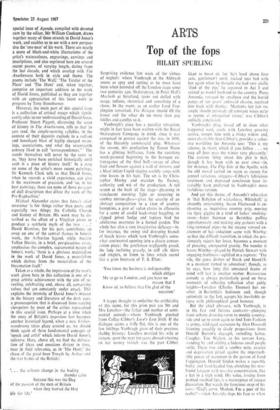Poet and painter
DAVID REES
Agenda Vol 5 Nos 1-3 David Jones Special Issue edited by Wiffiam Cookson (obtainable from 5 Cranbourne Court, Albert Bridge Road, London SW11, 12s 6d) Few who saw the 1954 exhibition of David Jones's work at the Tate Gallery will forget it, not least for the way in which this retro- spective collection showed how the work of poet and painter was impossible to separate. Of course, the themes of David Jones's later work had been seen as early as In Parenthesis (1937), which seemed to many critics as pos- sibly the most original creative work to come out of the First World War. And as both the range and the depth of David Jones's , vision became known to a new generation with The Anathemata (1952), it became quite clear that here was an artist who drew on the whole of our involved cultural history for the syn- thesis of his work.
The Greco-Roman past, the Matter of Britain in all its complexity, the religious heritage, all these influences converged in David Jones's work, and thus the artist's latest poems, a new example of his exquisite lettering, an occa- sional essay on the Roman roads of Britain, all have a place in a 'work in progress' that never ceases. With good reason Jones's work has been compared with that of Pound, Eliot and, above all, perhaps, James Joyce. This enlarged, special issue of Agenda, compiled with devoted care by the editor, Mr William Cookson, draws together many of these strands in David Jones's work, and enables us to see with a new perspec- tive the 'one-ness' of his work. There are nearly a score of black-and-white illustrations of the artist's watercolours, engravings, carvings and inscriptions, and also reprinted here are several recent poems, of varying length, dating from the last decade, and which overlap with The Anathemata both in style and theme. The
poems include 'The Wall,' The Tutelar of the Place' and 'The Hunt' and, taken together, comprise an important addition to the work of David Jones, published as they are together with an appreciation of this latest work in progress by Tony Stoneburner.
However, the main part of this special issue is a collection of critical essays which signifi- cantly adds to our understanding of David Jones. Professor Stuart Piggott, discussing the sense of history in The Anathemata, tells us that 'as you read, the simple-seeming syllables, in the context of their deposits explode in a radiant and beneficent blast of highly charged mean- ings, associations, and what the seventeenth century liked to call "correspondences."' The words themselves will never be the same to us, 'they have been enriched historically until each is a piece of history itself.' In a note on some of the artist's more recent paintings, Sir Kenneth Clark tells us that David Jones, when he records a vivid experience, can give it the maximum of precision, and `so, in his best paintings, there are none of those passages of dull description that dilute the work of the Pre-Raphaelites.'
Michael Alexander states that Jones's chief reverence 'is for things rather than poets. and especially two things; the Catholic Church and history of Britain. His work may be de- scribed as the effort of a Virgilian pietas to produce a synthetic myth of the two. . . David Blamires, for his part, contributes an essay on one of the central themes in Jones's work, the Arthurian legend, while Aneirin Talfan Davies, in a brief, perspicacious essay, emphasises the complex, sacramental nature of Jones's work; 'there is a glorious materialism in the work of David Jones, a materialism which derives from the materialism of the Incarnation itself.'
Taken as a whole, the impression of the man's work given here in this collection is one of a great artistic achievement with the aim of re- vealing, celebrating and, above all, conserving values that are constantly under attack. This explains the intensity of David Jones's interest in the history and literature of the dark ages, a preoccupation that is discussed from varying viewpoints by most of the critics represented in this special issue. Perhaps at a time when the story of Britain's impeaum fast becomes another historical legend, when a new Viiiker- wanderung takes place around us, we should think again of these fundamental concepts of 'epoch and artist' which inform David Jones's universe. Here, above all, we find the delinea- tion of ideas and emotions distant in time, near in their relevance, as in 'The Hunt,' the chase of the great boar Trwyth by Arthur and the war bands of the British:
. . the colours change in the boding thunder calm because this was the Day of the passion of the men of Britain when they hunted the Hoe life for life.'































 Previous page
Previous page